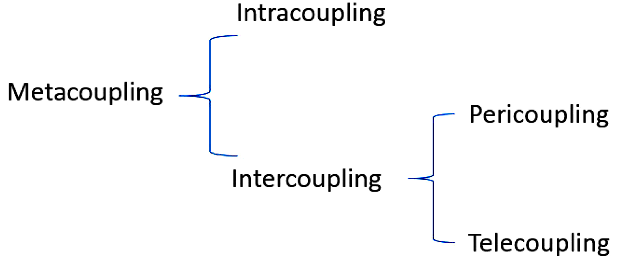Metacoupling
"As our world now is so tightly connected both socioeconomically and environmentally, and things are changing so fast, we simply don’t have the luxury of taking the easy way to find solutions. To understand fast and epic change, we need to change." -- Jianguo "Jack" Liu, Michigan State University sustainability scholar
Metacoupling is a new concept of research to systematically understand human-nature interactions (couplings), which can be classified into three major types: human-nature interactions within a coupled system (intracoupling), between distant coupled systems (telecoupling), and between adjacent coupled systems (pericoupling). Together, they constitute metacoupling. Metacoupling consists of intracoupling and intercoupling, which in turn includes pericoupling and telecoupling.
Metacoupled system is a holistic framework that integrates human-nature interactions within a system (intracoupling), between adjacent systems (pericoupling), and between distant systems (telecoupling). The metacoupling framework encompasses frameworks of intra-, tele-, and pericoupling as well as their interrelationships.

What's so meta about metacoupling - a layperson's guide
Humans and nature interact everywhere. With more people and less nature on the planet Earth, these interactions have become more complex and faster with more profound consequences.
In the past, there was fragmentary understanding of these interactions. To holistically understand them for global sustainability and human well-being, there is an urgent need for an integrated framework.
To address such a need, a novel framework of metacoupling has been developed.
What’s so meta about coupling?
Metacoupling means human-nature interactions across space – within a place (intracoupling), between adjacent places (pericoupling), and between distant places (telecoupling). It provides a new language to look at the big picture and at the detail simultaneously.
“As our world now is so tightly connected both socioeconomically and environmentally, and things are changing so fast, we simply don’t have the luxury of taking the easy way to find solutions,” he said. “To understand fast and epic change, we need to change. Fast.”
Jianguo “Jack” Liu, a sustainability scholar at Michigan State University, introduced “telecoupling” a few years ago.
Telecoupling refers to how distant connections between nature and human beings are growing ever tighter in a more globalized world—for good and for ill – a definition courtesy of Time Magazine in 2011. Funny word? Maybe. The telecoupling framework allows researchers to build models to understand socioeconomic and environmental interactions over distances. Since then, the telecoupling framework has been used to examine international trade, species invasion, migration, foreign investment, global fisheries management, biodiversity conservation, land use and more.
And, Liu argues, we need to take an even more holistic view of the world. A meta view.
So, here’s the scientific outline of metacoupling for nonscientists:
- Start with coupling:
- No… it’s not dirty. Couplings are the way two systems work together. Human and nature. Like giant pandas and the people who live with them in Wolong (Liu for years has been working to understand panda habitat in rural southwestern China. Lots of insights have flown from those mountains as the beloved bears and the people who live near them are locked in a struggle for mutual survival)
- Now… expand it to telecoupling
- You’ve got your pandas and people in China. Pandas are beloved and popular – and politically powerful. So, the Chinese offer panda for loans all over the world. They send them to zoos – like in Washington DC. That forms a telecoupled system - pandas and the people who care for them and share them with the public.
- So, these coupled systems have great distance between them, and we wonder what happens between these two distant coupled systems
- Think about transporting the pandas to their temporary homes – how many greenhouse gases released in those plane flights. What about what it takes to obtain enough bamboo to feed pandas in their new home, the people who care for them in zoos, those who market their presence, the companies who make the panda swag – dolls, keychains, hats – and the political and business machinations that come with panda diplomacy?
- It’s complicated.
- And it’s important to understand, because in all that back-and-forth comes a lot of things that affect the environment and livelihoods.
- Ok, so …. metacoupling.
- Metacoupling, Liu says, acknowledges that the world gets even more complex than telecoupling. Sometimes, it’s not about just distance. Liu says metacoupling is a way to examine the big picture, even as you also are understanding minutia
- So metacoupling means looking at the big picture – those pandas jet setting across the world making waves, but also understanding the closer actions
- In addition to telecoupling measuring the big picture over distance, there’s also the panda actions and affects close to their home, like, making sure enough bamboo is grown to feed them and protecting panda habitat. Understanding the management of land where pandas live – including conservation programs that limit harvesting wood. That internal action is intracoupling
- And… then there’s the effects right next door.
- Or, as we call it, pericoupling. Wolong’s home to some 10 percent of world’s wild giant pandas, as well as about 5,000 people. Being a panda hotspot has made Wolong a tourist attraction, so it more prosperous than some of its neighboring villages. The paper notes some women marry into Wolong families, motivated by the economic boost.



 Print
Print Email
Email